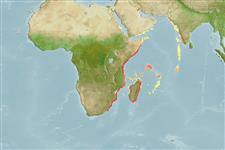Common names from other countries
Environment: milieu / climate zone / depth range / distribution range
Écologie
marin; eau douce; saumâtre démersal; catadrome (Ref. 51243). Tropical
Africa: Kenya to South Africa (Ref. 3506), uncommon south of the Save River (Ref. 7248, 52193). Also Reunion and Mauritius (Ref. 33390). Dominant eel species in the Zambezi system and farther north in East Africa (Ref. 52193).
Taille / Poids / Âge
Maturity: Lm ? range ? - ? cm
Max length : 175 cm TL mâle / non sexé; (Ref. 48660); poids max. publié: 20.6 kg (Ref. 52193); âge max. reporté: 15 années (Ref. 48660)
Épines dorsales (Total) : 0; Épines anales: 0.
Migratory species which breeds in the ocean (Ref. 52331), it requires rivers and oceans (Ref. 30558). Young fish migrate upstream with a continued feeding mode, especially on invertebrates found on rocks and logs washed by fast moving waters (Ref. 30558). They inhabit various niches in a river system (Ref. 13337) and penetrate far inland, surmounting formidable barriers in its upstream migration, including the Kariba and Cahora Bassa dams (Ref. 52193). Adults need moving water to migrate back to the ocean, especially after heavy rains (Ref. 30558). Their food consists of crabs, frogs and insects (Ref. 30558), and even fish, including trout in the streams of the eastern highlands of Zimbabwe (Ref. 2478, 52193). Caught with various types of nets.
Life cycle and mating behavior
Maturities | Reproduction | Spawnings | Egg(s) | Fecundities | Larves
Skelton, P.H., 1993. A complete guide to the freshwater fishes of southern Africa. Southern Book Publishers. 388 p. (Ref. 7248)
Statut dans la liste rouge de l'IUCN (Ref. 130435)
CITES (Ref. 128078)
Not Evaluated
Menace pour l'homme
Harmless
Utilisations par l'homme
Pêcheries: commercial; pêche sportive: oui
Outils
Articles particuliers
Télécharger en XML
Sources Internet
Estimates based on models
Preferred temperature (Ref.
115969): 25 - 28.7, mean 27.1 (based on 306 cells).
Phylogenetic diversity index (Ref.
82804): PD
50 = 0.5000 [Uniqueness, from 0.5 = low to 2.0 = high].
Bayesian length-weight: a=0.00074 (0.00040 - 0.00138), b=3.18 (3.02 - 3.34), in cm Total Length, based on LWR estimates for this species & Genus-body shape (Ref.
93245).
Niveau trophique (Ref.
69278): 3.8 ±0.7 se; based on size and trophs of closest relatives
Résilience (Ref.
120179): Faible, temps minimum de doublement de population : 4,5 à 14 années (tmax=15).
Fishing Vulnerability (Ref.
59153): Very high vulnerability (90 of 100).
